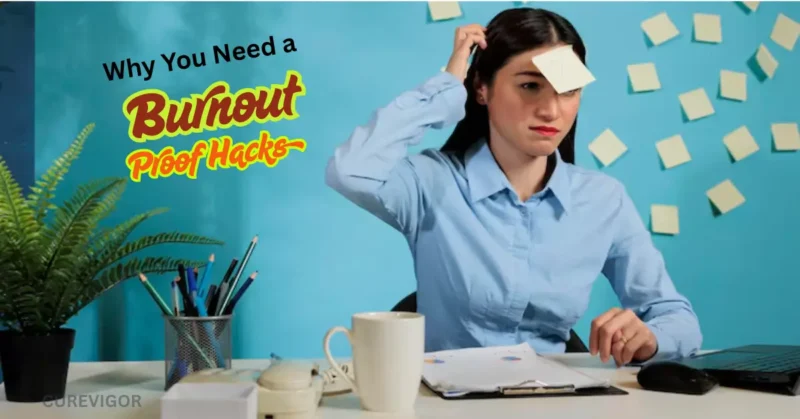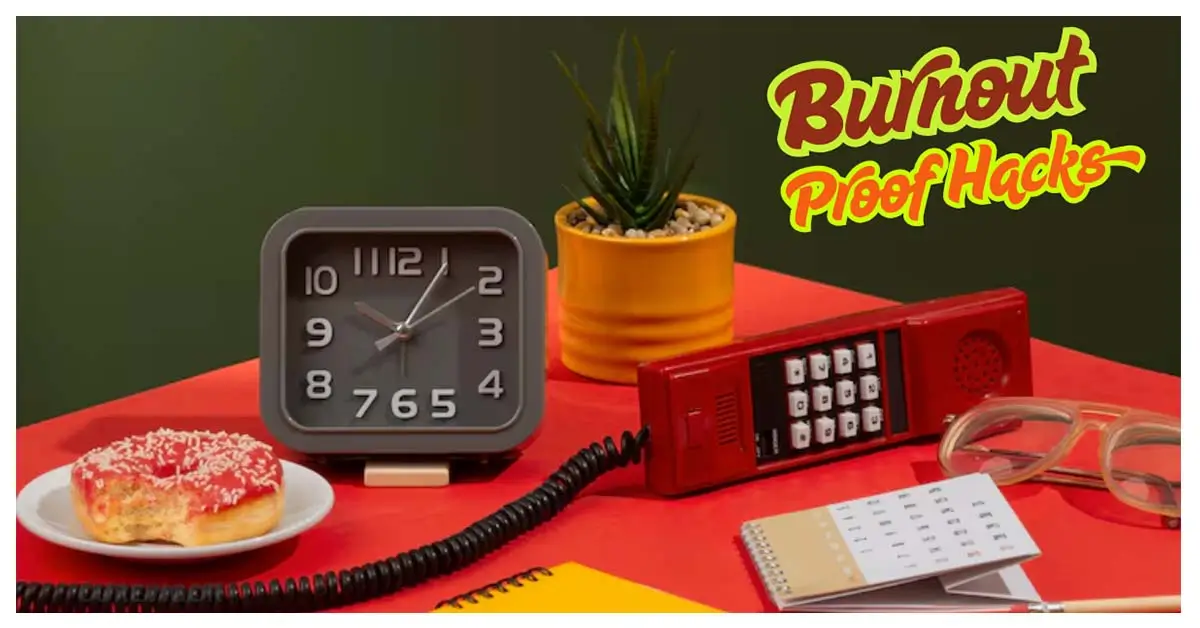Feeling exhausted but still need to function? These burnout-proof routine hacks help you stay productive without overexerting yourself—realistic, sustainable strategies for daily life when you’re running on empty.
Thank you for reading this post, don't forget to subscribe!How to Build Burnout-Proof Routines That Work Even When You’re Exhausted
Let’s be real—some days, just brushing your teeth feels like a win. When you’re burned out, traditional productivity advice can feel more like pressure than a helpful resource. That’s why you need burnout-proof routine hacks: practical, low-lift adjustments that respect your energy while still keeping life moving. These aren’t just tips—they’re survival tools for functioning gently when your tank is nearly empty.
Before we dive in, this blog is the third in a 3-part burnout series.
- The first post explored burnout warning signs and expert-approved recovery strategies, helping readers spot the problem early and start healing.
- The second was a deeply personal journey, where I shared the 7 powerful things I did to finally stop feeling burned out all the time—raw, reflective, and real.
- This post? It’s for those still in the thick of it. You’re drained, but life doesn’t stop. These are daily hacks to help you move forward gently and sustainably.
Why You Need a “Burnout-Proof” Routine

When exhaustion sets in, traditional productivity advice falls flat. “Wake up earlier,” “Just push through,” or “Try a 5 a.m. morning routine” can make things worse.
What you need is a flexible rhythm, not a rigid routine. One that meets you where you are, protects your energy, and still gets essential tasks done.
These hacks are designed to help you function without pushing yourself to the point of collapse.
1. Use Micro-Tasks Instead of To-Do Lists
Forget 10-item checklists. When you’re running on low energy, even the simplest task can feel overwhelming.
Instead, break tasks into micro-steps.
Rather than “clean kitchen,” write:
- Take out the trash
- Load dishwasher
- Wipe counters
Each micro-win builds momentum without burnout.
2. Embrace the 3-Minute Rule
The 3-minute rule is magic when you’re mentally worn out:
If a task takes less than 3 minutes, do it now.
If not, schedule it—or scrap it.
It prevents minor to-dos from snowballing into mental clutter.
Bonus: You’ll be surprised how many things take less than 3 minutes—like replying to that email or putting away the laundry.
3. Design “Low-Energy” and “High-Energy” Versions of Your Day
On some days, you may have more to give. On others, just getting out of bed feels like a win. Build two versions of your routine:
High-energy mode:
- Morning journaling
- 20-minute walk
- Focused work sprint
Low-energy mode:
- 2-minute stretch in bed
- Voice note thoughts instead of journaling
- One Pomodoro session, then rest.
Having both plans permits you to adapt without guilt.
4. Stack Habits You Already Do (But Make Them Easier)
Exhausted brains crave simplicity. Habit stacking helps you do more without overthinking.
Example:
While waiting for coffee to brew, take 3 deep breaths.
While brushing your teeth, stretch your neck and shoulders to help relieve tension.
These tiny rituals don’t require extra effort, but they help you stay grounded and regulated.
5. Schedule Buffer Time Like It’s a Meeting
When you’re burnout-prone, jumping from task to task isn’t just hard—it’s harmful. Build in white space.
Block off time between meetings or tasks to:
- Breathe
- Hydrate
- Mentally reset
It slows the cortisol spikes and gives your brain time to process, not just produce.
6. Use the “One Thing That Matters” Focus Strategy
If everything feels urgent, nothing gets done. Instead of juggling 10 tasks, ask:
“What’s the one thing I can do today that will move the needle just a little?”
It could be finishing a report, sending a key email, or just resting to recharge.
Some days, your one thing might be rest, and that’s valid.
7. End Your Day with a Gentle Wind-Down Cue
Forget forcing yourself into an elaborate night routine.
All you need is one consistent cue that tells your brain: “It’s safe to slow down now.”
Ideas:
- Dim lights and calming music
- Set a “phone off” alarm.
- Make a cup of herbal tea.
This daily cue helps your nervous system shift out of survival mode.
Burnout Doesn’t Mean You’re Broken—It Means You Need a New Rhythm
The goal here isn’t to power through. It’s to create a pace you can live with.
These hacks aren’t magic fixes—but they’re practical lifelines for functioning through exhaustion with compassion, not shame.
Burnout-proofing your routine isn’t lazy. It’s wise, intentional self-preservation.
FAQs
Q. How do you stay productive when you’re mentally exhausted?
When mental exhaustion strikes, shift your focus from perfection to progress. Focus on small, meaningful tasks using techniques like the “One Thing That Matters” method. Break tasks into micro-steps and allow extra time for transitions. Use energy-matching routines—low effort on hard days, more focused on better ones. Schedule buffer zones to prevent overwhelm. Rest is not a reward; it’s part of sustainable productivity. Treat your brain like a battery that needs to be recharged.
Q. What are simple daily routine hacks for burnout recovery?
Burnout recovery isn’t about doing more—it’s about doing things differently. Start by incorporating habits into existing routines (e.g., taking deep breaths during coffee). Use the 3-minute rule to prevent mental clutter. Maintain consistency in your mornings and evenings with simple cues, such as soft lighting or music. Build both high- and low-energy versions of your day. Focus on one key task daily instead of multitasking. Always include rest time, even if it’s just 10 minutes of stillness.
Q. Can you work through burnout without exacerbating it?
Yes—but it requires radical self-awareness and adjusted expectations—ditch hustle mode and lean into energy-preserving strategies. Reduce your cognitive load by planning and sticking to micro-tasks. Prioritize rest like a non-negotiable meeting. Avoid stimulants and over-scheduling that mask the symptoms. Delegate, delay, or delete non-essential commitments. Most importantly, track your energy and stop before depletion, not after.
Q. How do I know if my routine is contributing to burnout?
If your routine leaves you more drained than restored, it’s a red flag. Watch for signs like dreading your day, constant brain fog, or feeling emotionally flat. A burnout-aggravating routine often ignores breaks, lacks flexibility, and prioritizes output over well-being. You may also notice sleep disturbances or a tendency to procrastinate frequently. Rigid routines during burnout backfire. A healthy routine should feel supportive, not like a never-ending checklist. Modify your schedule to match your energy, not your calendar.
Q. What’s the best routine for someone recovering from burnout?
There’s no one-size-fits-all, but the best routine is one that respects your limits. Start with gentle structure—wake-up windows, hydration, and brief movement. Use habit stacking to reintroduce small acts of care without pressure. Create a flexible plan with space for both work and decompression. Monitor your feelings each day and adjust accordingly. Wind down consistently with screen-free time and soothing rituals. Over time, your routine becomes a form of recovery, not another task.
Summary: Burnout-Proof Routine
Staying productive during mental exhaustion starts with shifting your mindset from perfection to progress. Focus on one small, meaningful task at a time and match your energy level with your activities. Simple routine hacks—like habit stacking, 3-minute resets, and flexible planning—can support your recovery without overwhelming you.
Working through burnout is possible if you adjust your expectations radically, reduce your mental load, and prioritize rest as a core part of your daily routine. If your routine leaves you more depleted than energized, it may be making things worse. Watch for signs like persistent dread, emotional numbness, or cognitive fatigue.
The best routine for someone recovering from burnout is gentle, adaptive, and energy-conscious. It includes hydration, soft structure, small wins, and consistent wind-down rituals. Most importantly, it grows with you, helping you heal instead of adding pressure.
Read more articles on Health Tips.
You might like:

